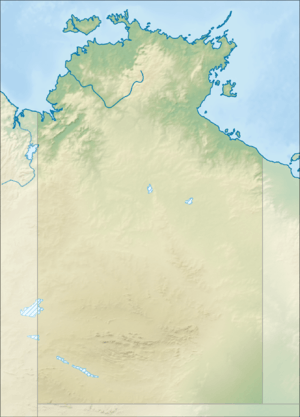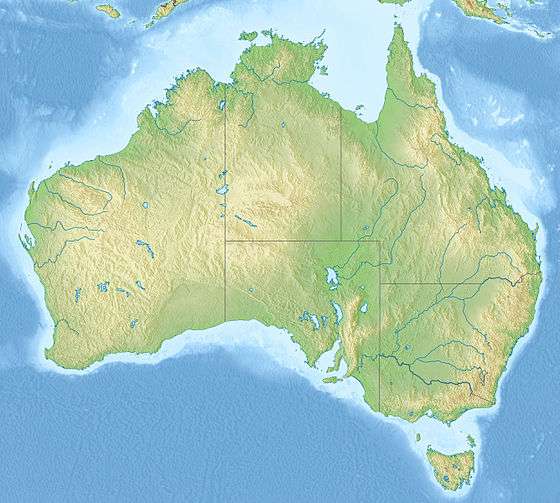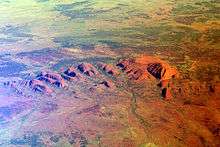Kata Tjuta
Kata Tjuṯa, (Pitjantjatjara: Kata Tjuṯa, lit. 'many heads'; Aboriginal pronunciation: [kɐtɐ cʊʈɐ]), also known as the Olgas, is a group of large, domed rock formations or bornhardts located about 360 km (220 mi) southwest of Alice Springs, in the southern part of the Northern Territory, central Australia. Uluru, also known as Ayers Rock, located 25 km (16 mi) to the east, and Kata Tjuṯa form the two major landmarks within the Uluru-Kata Tjuṯa National Park. The park is considered sacred to the Aboriginal people of Australia.[2]:884
| Kata Tjuṯa / Mount Olga | |
|---|---|
 | |
| Highest point | |
| Peak | Mount Olga |
| Elevation | 1,066 m (3,497 ft) [1] |
| Prominence | 348 m (1,142 ft) |
| Coordinates | 25°18′S 130°44′E |
| Naming | |
| Native name | Kata Tjuta |
| Geography | |
 Kata Tjuṯa / Mount Olga Uluru-Kata Tjuṯa National Park  Kata Tjuṯa / Mount Olga Kata Tjuṯa / Mount Olga (Australia) | |

The 36 domes that make up Kata Tjuṯa cover an area of 21.68 km2 (8.37 sq mi), are composed of conglomerate, a sedimentary rock consisting of cobbles and boulders of varying rock types including granite and basalt, cemented by a matrix of sandstone. The highest dome, Mount Olga, is 1,066 m (3,497 ft) above sea level, or approximately 546 m (1,791 ft) above the surrounding plain (198 m (650 ft) higher than Uluru).[1] Kata Tjuta is located at the eastern end of the Docker River Road.
Name
The other name, The Olgas, comes from the tallest peak, Mount Olga. At the behest of Baron Ferdinand von Mueller, Mount Olga was named in 1872 by Ernest Giles, in honour of Queen Olga of Württemberg (born Grand Duchess Olga of Russia, daughter of Tsar Nicholas I). She and her husband, King Charles I of Württemberg, had marked their 25th wedding anniversary the previous year by, amongst other things, naming Mueller a Freiherr (baron), making him Ferdinand von Mueller; that was his way of repaying the compliment.[3]
On 15 December 1993, a dual naming policy was adopted that allowed official names consisting of both the traditional Aboriginal name and the English name. As a result, Mount Olga was renamed Mount Olga / Kata Tjuṯa. On 6 November 2002, following a request from the regional Tourism Association, the order of the dual names was officially reversed, to Kata Tjuṯa / Mount Olga.[4]
Geologic origin
The region surrounding Kata Tjuṯa lies in the Amadeus Basin, an intracratonic basin formed during the Adelaidian, roughly 850–800 million years ago.[5] During the Petermann Orogeny, approximately 550 million years ago, an event known as the Woodroffe Thrust lifted granulite facies rocks northward over low-grade metamorphic rocks. The eventual erosion of the formation resulted in a molasse facies, or deposition in front of rising mountains, in this case the Petermann Orogeny, to create the deposit known as the Mount Currie Conglomerate. The Mount Currie Conglomerate is made predominately of basalt, porphyry, granite, gneiss and volcanic rock fragments with a matrix composed of angular quartz, microcline and orthoclase among other minerals.
Both Uluru and the Kata Tjuṯa are made of sediment originating in this Mount Currie Conglomerate and both have a chemical composition similar to granite. Scientists using Rb/Sr dating techniques to accurately date the rock have given it an age of 600 million years, matching the date of the Woodroffe Thrust event. The actual fresh rock that makes up the Kata Tjuṯa and Uluru is medium to dark grey with green or pink hues in some laminae. The bright orange-red hue, for which the structures are noted, is due to a patina over finely divided feldspar coated in iron oxide.[6]
Legends
There are many Pitjantjatjara Dreamtime legends associated with this place and indeed everything in the vicinity including Uluru. A number of legends surround the great snake king Wanambi, who is said to live on the summit of Kata Tjuṯa and only comes down during the dry season. His breath was said to be able to transform a breeze into a hurricane in order to punish those who did evil deeds.[7] The majority of mythology surrounding the site is not disclosed to outsiders, and in particular, women. As is the custom, should women become privy to the "men's business", they are susceptible to violent attacks, even death. The Anangu people believe the great rocks of Kata Tjuṯa are homes to spirit energy from the 'Dreaming', and since 1995 the site is being used once again for cultural ceremonies.[2]:884–885
Transport
Kata Tjuṯa / Mount Olga can be reached via Ayers Rock Airport, followed by a 55-kilometre (34 mi) drive south, then west. Visitors are required to pay an entry fee.[8] Kata Tjuṯa is about 495 kilometres (308 mi) by road from Alice Springs, via the Stuart and Lasseter highways. It is a 4 1⁄2 hour drive.
Gallery
 In the Valley of the Winds walk at Kata Tjuṯa / Mount Olga.
In the Valley of the Winds walk at Kata Tjuṯa / Mount Olga. Kata Tjuṯa / Mount Olga.
Kata Tjuṯa / Mount Olga.- Astronaut photo of Kata Tjuṯa / Mount Olga.
 In Uluru Kata Tjuṯa National Park
In Uluru Kata Tjuṯa National Park Kata Tjuṯa / Mount Olga, Australia
Kata Tjuṯa / Mount Olga, Australia
See also
- Ernest Giles
- Protected areas of the Northern Territory
- Pitjantjatjara people#Recognition of sacred sites
- Tietkens expedition of 1889
References
- Uluru-Kata Tjuta National Park Visitors Guide. Retrieved 26 April 2013
- Engels, Christoph (2010). 1000 Sacred Places. Tandem Verlag GmbH.
- Whitlam Institute, University of Western Sydney Archived 2005-07-19 at the Wayback Machine. Retrieved 28 March 2007
- Northern Territory Government — NT Place Names Register. Retrieved 17 November 2007
- http://www.environment.gov.au/parks/uluru/nature/geology.html
- Rowland Twidale, Charles (2010). "33: Uluru (Ayers Rock) and Kata Tjuta (The Olgas); Inselbergs of Central Australia". Geomorphological Landscapes of the World. Springer. ISBN 978-90-481-3054-2
- Scheffel, Richard L.; Wernet, Susan J., eds. (1980). Natural Wonders of the World. United States of America: Reader's Digest Association, Inc. p. 278. ISBN 0-89577-087-3.
- "Passes and permits". Parks Australia. Retrieved 2017-09-28.
External links
| Wikimedia Commons has media related to Kata Tjuta. |
- Uluṟu - Kata Tjuṯa National Park - Australian Department of the Environment and Water Resources
- A Report on the Uluru-Kata Tjuṯa National Park
- Uluru-Kata Tjuta park on Parks Australia (Australian Government)
